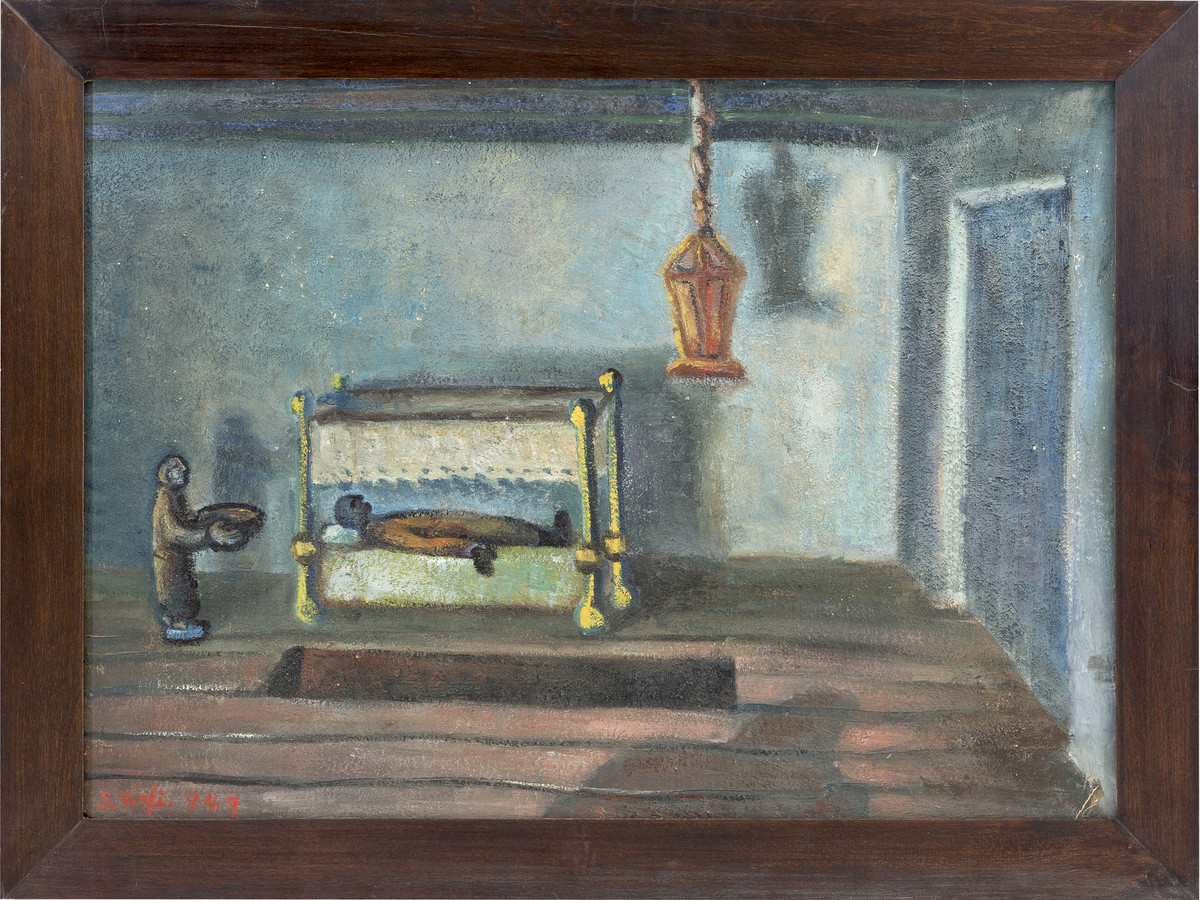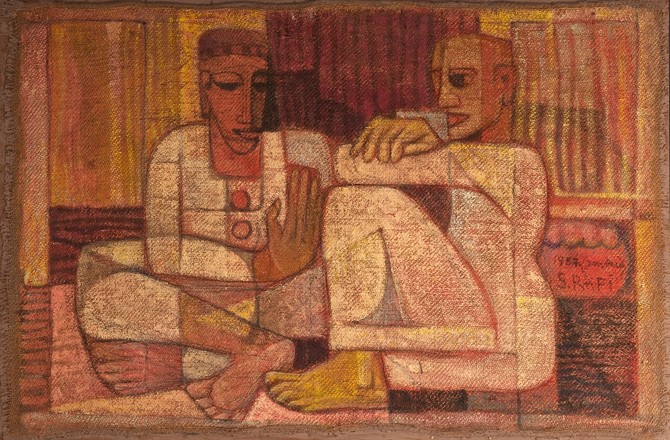http://www.arabnews.com/node/1444256/art-culture
Samir Rafi show puts surrealism in the spotlight
- Green Art Gallery currently is showcasing an exhibition on the late Egyptian modernist artist Samir Rafi until March.5
- Rafi's compositions are sometimes surreal and always thought-provoking, from lonesome figures to menacing wolf-like dogs, often intertwined with political and personal narratives
DUBAI: "I really wanted to spotlight an artist who hasn't had the recognition that he deserves and hasn't been shown properly," says Yasmin Atassi, director of Dubai's Green Art Gallery. She is talking about the gallery's current exhibition — a solo retrospective of the late Egyptian modernist Samir Rafi.
"He was a deeply intellectual artist, who created his own visual language and universe that is full of symbolism," Atassi explains.
Considered one of Dubai's first contemporary art galleries, Green Art Gallery opened in 1995 as a salon d'art in the neighborhood of Jumeirah. Pioneers of modern Arab art — including Iraq's Dia Azzawi, the late Syrian artist Fateh Moudarres, and Lebanon's Hussein Madi — roamed the halls of the gallery and showcased their works to enthusiasts and collectors.
Once a year, the gallery, which has sinced moved to Al-Serkal Avenue, steers away from its contemporary art shows of conceptual installations and digital art and goes back to basics, developing research-driven exhibitions of a historical context, revealing museum-quality works by Middle Eastern luminaries of the twentieth century.

"We aim to go back to Green Art Gallery's roots, since the gallery is steeped in the modern art history of the region," Atassi says. "I also think that we have the audience for it, because the younger generation is interested in the older generation."
This year, it is Rafi's turn to shine. "Spotlight on Samir Rafi" runs through March 5. It is Rafi's first solo exhibition in the Gulf, and includes 13 works gathered from his family's estate, and from private and public collections. The works range from delicate pieces on paper to elaborate oil paintings and were all created between the 1940s and the 1990s.
Rafi was born in Cairo in 1926, and gained a scholarship to the Sorbonne in Paris in the early Fifties. He lived in the French capital until his death in 2004.
His sometimes surreal and always thought-provoking compositions, from lonesome figures to menacing wolf-like dogs, often intertwine political and personal narratives. Despite his powerful work, his willingness to experiment with a variety of mediums, and his uncensored and passionate style, however Rafi remains one of the lesser-explored figures of Egyptian modern art, even though he is associated with groundbreaking artistic movements that were birthed in Egypt during the politically and culturally tumultuous twentieth century.
Early in his career, Rafi was invited by the Art et Liberté collective to participate in a couple of their exhibitions. Composed of both Egyptians and foreigners, this short-lived yet highly productive group of artists, established in Cairo in the late 1930s, was deeply influenced by the imaginative realm of surrealism.
"This was during post-independence Egypt. It was a hotbed for intellectuals, poets, writers, and photographers who were fleeing the war in Europe," Atassi says. "The Art et Liberté group were trying to create a new art form for the people in Egypt, because they felt the old art form was very provincial and conservative."

On display at the exhibition, one finds a rare, blue-colored, dreamlike drawing — a close-up of a hand holding onto plants ¬— executed in 1943, when Rafi was a 17-year-old student, revealing his surrealist tendencies early on in his career.
After the dismantlement of the Art et Liberté group, a new artistic identity was formed through the birth of the Contemporary Art Group during the mid-1940s, of which Rafi was an integral, co-founding, member. The group was fueled by nationalism — inspired by the rise of the Egyptian leader Gamal Abdel Nasser — leading to the creation of authentically Egyptian imagery in a modern manner.
"The Contemporary Art Group wanted to convey what Egypt was all about, they had felt that the Art et Liberté group was a little too Westernized," Atassi explains.
Like many artists of his time, despite his modernist tendencies, Rafi was deeply inspired by the history of art, most notably the iconic figures of ancient Egyptian art and Nubian wall paintings. Such references can be seen, for instance, in his pen-on-paper drawing from 1950 depicting a woman whose posture resembles that of the statuesque hieroglyph carrying plants while being guarded by a wolfdog.
One of the larger works on display is "The Visit," a magnificent and sensual painting on a rug, which was created in 1965. Like much of Rafi's work, the piece invites viewers to form their own interpretation — one can sense some kind of power play occurring between the composition's two subjects: a man and a woman standing side by side. A striking element of the image is the sense of empowerment exuded by the voluptuous, nude woman. With her wide eyes and dark hair, her quiet confidence contrasts that of the vulnerable man whose hands are tied. Perhaps the constrained man symbolizes Egypt and its people, whereas the woman offers hope, freedom, and light, emphasized by the candle she carries.

Looking into Rafi's works from the 1970s — a time of regional uncertainty marked by the death of Nasser in 1970 and the Arab-Israeli War in 1973 — his 'trademark' depiction of the wolfdog becomes increasingly apparent, creating a constant tension and adding a political undertone to his work. In one picture, Rafi depicts two wolves devouring each other. In another, a snarling wolfdog gains power as a man is imprisoned in a cage.
According to Myrna Ayad, a Dubai-based independent arts consultant who oversaw the growth of the Modern section as former director of Art Dubai, the wolf likely speaks of Rafi's frustrations with the status quo of the region.
"Rafi's work is highly sensual and highly political," Ayad tells Arab News. "I think the wolf is a metaphor for the ugliness of mankind. I think Rafi was trying to say that we, as mankind, can be animalistic and aggressive. Artists like Rafi were not immune to their surroundings and were the greatest historians because they were recording their own interpretation."
Not all the images on display contain such stark and heavy content. 1957's "Two Crouching Men," for example, a depiction of villagers — a favored theme among Egyptian artists at that time, exudes a peaceful ambience with its earthy tones and geometry. And as one leaves the exhibition a raw painting of a man lying on a (death)bed suspended over a hole in the floor — "Life's Tragedy" — reminds the viewer of the inevitability of endings. Yet despite its grim title, this calm composition, painted in the early years of the Contemporary Art Group era, also seems to represent a kind of liberation and rebirth.
-- Sent from my Linux system.

No comments:
Post a Comment